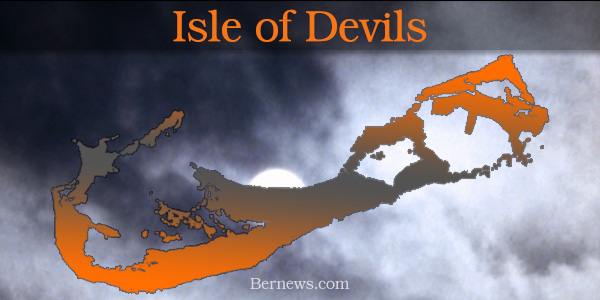Looking At The Tale Of The “Isle Of Devils”
[Written by Juanae Baker]
Imagine a cool windy night with the moon as your only source of light. The ebb and flow of the waves rock you back and forth, up and down. In the darkness you hear only the echoes of animals unknown. Strange creatures fly about in packs, seemingly to devour you.
In the blackness of night you strain to see what lay before you. Rain fall and gushes of water flood your vessel. Your vision is blurred by the elements and before you know you have lost control and find yourself lodged in treacherous rock. You are sure that this is the end, the bitter end you have always feared.
These are the tales of shipwrecks that whispered through the European docks and told stories of Bermuda’s witches, demons and sea monsters. It is no wonder the island so many of us call home was once known as The Isle of Devils.
Bermuda has long been a part of Western folklore because of its stormy weather, the unfamiliar sounds of our native birds, the deadly ring of reefs that conquered many oncoming ships, the echo of the caves and the screeching of wild hogs.
The discovery of Bermuda in the early 1500’s put the island on the global map, but for over a century its reputation was tainted by tales of misadventure. With over thirty confirmed shipwrecks in and around Bermuda’s waters before the year 1600, sailors and explorers alike avoided our shores. Much different from the anticipation that often precedes a visit to these islands today, no one wanted to find themselves in such bad fortune to be near The Isle of Devils.
Many have lived to tell the tale of their encounter with “La Bermuda”. Gonzalo Fernandez chronicles his brush with the island and it’s “flying fishes”, “sea mewes” and “cormorants” in his 1515 publication of La Historia General y Natural de las Indias [The General and Natural History of the Indies]. And later Sir Walter Raleigh, an English aristocrat, writer and explorer, in 1596 describes Bermuda as a “hellish sea for thunder, lightning and storms.”
Bermuda’s superstitious reputation was so prominent in Elizabethan culture that it was featured in the works of some of the most celebrated writers of that era. John Donne in his 1597 poem The Storme uses Bermuda as a metaphor to describe his near death experience on the sea, writing “Compared to these stormes, death is but a qualm, Hell somewhat lightsome, the Bermudas calm.” And while Donne himself had never ventured to our shores, this reference confirms that “the Bermudas” was a well-known Elizabethan idiom for turbulence and danger.
So well-known is the tale of The Isle of Devils, it is believed to have inspired the last of the great William Shakespeare plays. In The Tempest Shakespeare tells the story of a romance birthed in a great storm. He describes a mysterious island. Though located in the Mediterranean, its features mirror that of Bermuda, filled with hogs, seabirds and drinks made of cedarberries. Indeed the similarities are great, and written in 1611, two years after the Sea Venture shipwreck, it is not too farfetched of a notion.
Interestingly enough, despite the reports of demons and disasters, anyone who suffered the misfortune of landing in Bermuda was quick to find that the tales were untrue. Once the day broke they would discover the strange sounds that bellowed in the night were just that of wild hogs and indigenous birds that made a great meal after a long voyage.
Instead of devils and sea monsters, settlers were met with crystal clear waters and in place of spirits they found much needed spiritual sustenance and serenity to continue their journey. Silvanus Jourdan, in his account of the Sea Venture shipwreck, described Bermuda saying, “it hath been and is still accounted, the most dangerous, infortunate, and most forlorn place in the world, it is in truth the richest, healthfullest, and pleasing land.” How deceiving the reputation of the The Devils Isle had been!
William Strachey, secretary-elect of Virginia and passenger aboard the Sea Venture, in his letter describing the 1609 shipwreck said it best, “The Devils Isles…are feared and avoided of all sea travellers alive, above any other place in the world. Yet it pleased our merciful God, to make even this hideous and hated place both the place of our safety and means of our deliverance.”
How ironic that a place once condemned as an isle of devils would serve as salvation for the English colony of Virginia and play such a pivotal role in the settlement of one of the world’s greatest nations. How interesting that this same island that was feared by “all sea travellers alive” would be a top ten holiday destination, visited by major cruise lines and regarded as one of the most peaceful and tranquil places on earth.
Just like anything else in life, once you conquer the fear of it you are able to see its beauty; the tale of The Isle of Devils is no exception.



Awesome article!! I’ll be sharing this with my students after the break as we are studying the journey of the Sea Venture right now! #exciting
Exactly article, Juanae Baker! I would love to be able to use this during my Bermuda Blue Flag Ambassador Tours.
Looking forward to more history lessons!